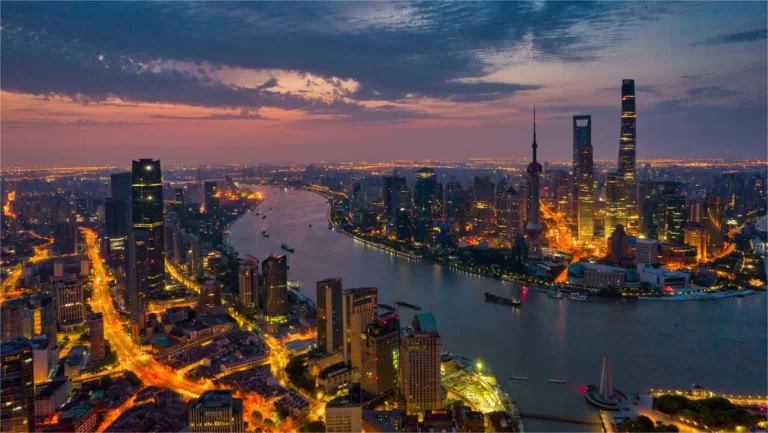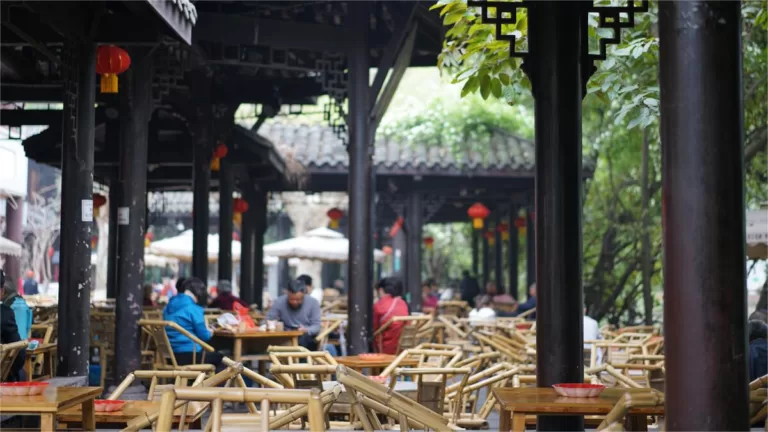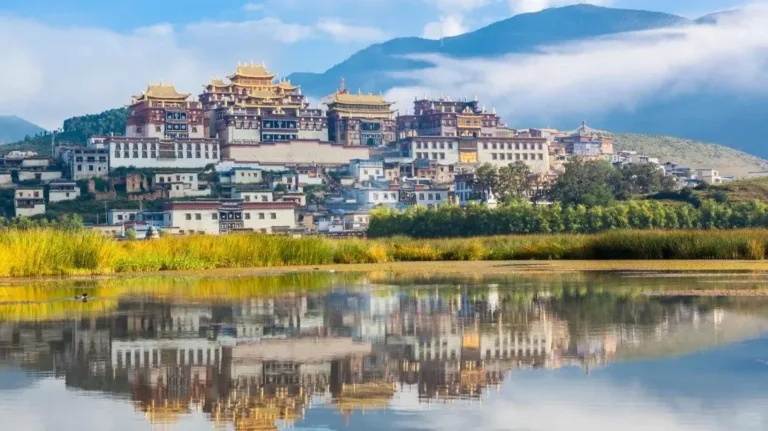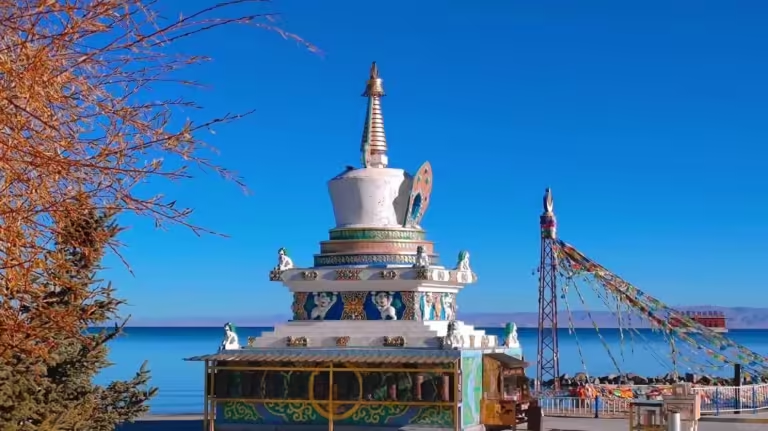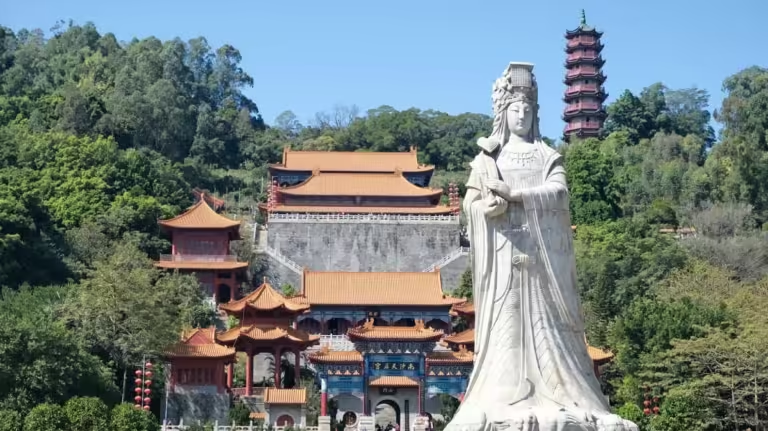Chinatripedia
Everything You Need to Know about Traveling in China
China Travel Guide
Beijing, situated in the northern part of the North China Plain, is surrounded by the Yanshan and Taihang mountain ranges. It is not just a capital city...
Shanghai, a city as deep and enchanting as the sea, has evolved from a quaint Jiangnan town two hundred years ago to a vast metropolis teeming with countless...
With a rich history and profound cultural heritage, Shaanxi boasts three UNESCO World Heritage Sites: the Great Wall, the Terracotta Army of Qin Shi Huang,...
Tianjin, located along the Bohai Sea in the northern part of China, is a vibrant city adjacent to the capital, Beijing. Its strategic geographical position...
Sichuan Province, situated in the southwest hinterland of China, marks the headwaters of the Yangtze River. Its western region encompasses the Qinghai-Tibet...
Hebei Province, situated in the heart of the North China Plain along the northern banks of the Yellow River, earns its name from its geographical positioning...
Chongqing, situated in the southwestern part of China along the upper reaches of the Yangtze River, holds a rich history as a wartime capital and attained...
Jiangsu Province boasts incredibly rich tourism resources, with its natural and cultural landscapes centered around gardens, Taihu Lake, and the Yangtze...
Hubei, located in central China along the middle reaches of the Yangtze River and north of Dongting Lake, derives its name from its geographical position,...
Guizhou Province, often abbreviated as “Gui” or “Qian”, boasts Guiyang as its capital city. Situated in the southwestern part of...
Henan Province is considered the cradle of Chinese civilization and the heartland of the Chinese nation, serving as the historical and cultural center...
Zhejiang Province is located on the southeastern coast of China, at the southern wing of the Yangtze River Delta, with Hangzhou as its capital. Historically,...
Yunnan Province, located in the southwestern frontier of China, has its capital in Kunming. During the Warring States period, it was home to the Dian tribe....
Shandong Province, the birthplace of Confucian culture and home to famous philosophers such as Confucius and Mencius, is rich in historical significance....
Fujian Province, abbreviated as “Min,” is located on the southeastern coast of China, facing Taiwan across the Taiwan Strait. With a forest...
Gansu Province, abbreviated as Gan or Long, derives its name from the historical regions of Ganzhou (modern-day Zhangye) and Suzhou (now Jiuquan). This...
Guangxi, located in southern China, is a region of stunning landscapes and vibrant culture. Positioned on the southeastern edge of the Yunnan-Guizhou Plateau,...
Jiangxi, also known as “Ganpo Land” or “Gan,” gets its name from the Gan River and was officially established as Jiangnan West...
Heilongjiang Province, named after the Heilong River (also known as the Amur River), is the northernmost and easternmost province in China. It is the province...
Shanxi, located in the northern part of China, is rich in cultural heritage and boasts numerous well-preserved historical sites. The province is home to...
Anhui Province is located in the central-eastern part of China, and its name dates back to the Spring and Autumn Period and the Warring States Period....
Liaoning Province, abbreviated as “Liao,” is located in the southern part of Northeast China. Its capital is Shenyang. The province borders...
When you think of Inner Mongolia, the image that likely comes to mind is its vast and free-spirited grasslands. The wide blue skies, crystal-clear lakes,...
Hunan Province, located in the middle reaches of the Yangtze River in southern China, is named “Hunan” due to its location south of Dongting...
Latest articles
Changchun Zoological and Botanical Park (长春动植物公园), covering 74 hectares with 8.8 hectares of water and 0.8 hectares of buildings, is a specialized park...
Baishui Village (白水寨, Baishuizhai, White Water Village) is located in Zengcheng District, Guangzhou, covering an area of approximately 170 km². It lies...
Erlangjian Scenic Area (二郎剑景区), located on the southern side of Qinghai Lake, is one of the main attractions in the region. The scenic area is divided...
Nansha Tianhou Palace (南沙天后宫), also known as the Mazu Temple (妈祖庙), is located in Guangzhou, China, and spans an impressive area of 180,000 square meters....
The Museum of the History of Northeast China’s Occupation (东北沦陷史陈列馆) covers an area of 26,500 square meters and was officially opened on September...
The Jinyintan Grasslands (金银滩草原), located in the Qinghai Province, is a vast expanse of natural beauty spanning approximately 1,100 square kilometers....
Huangpu Old Port (黄埔古港) is located in Haizhu District, Guangzhou. In 1685, the Qing government established the Canton Customs House, and all foreign merchant...
The Eight Departments of Manchukuo (伪满八大部) were the primary governing bodies of the puppet state of Manchukuo, established in 1932 when the last Chinese...
Daotang River (倒淌河), located in the northwest of China, originates from the western side of Sun and Moon Mountain. It stretches over 40 kilometers and...
Beijing offers a wide variety of hotels and accommodations, ranging from luxury hotels to budget-friendly options. Throughout the city, visitors can find...
The Former Site of Whampoa Military Academy Museum (黄埔军校旧址纪念馆) covers an area of 71,939 square meters with an exhibition space of 1,700 square meters....
Changchun World Sculpture Park (长春世界雕塑园) covers an area of 92 hectares, including 11.8 hectares of water. The park features 454 sculptures created by 404...
Qinghai Lake (青海湖), historically known as “Xihai (西海/West Sea)” and also called “Kuku Nor,” which means “blue sea”...
Chaka Salt Lake (茶卡盐湖), located in the Haixi Mongolian and Tibetan Autonomous Prefecture of Qinghai Province, China, sits at an average altitude of 3,059...
Guangdong Museum (广东博物馆), initially planned in 1957 and officially opened in 1959, is the only comprehensive provincial museum in Guangdong. In 2004, construction...
Changchun Nanhu Park (长春南湖公园) is the second-largest urban park in China, following the renowned Summer Palace in Beijing. Originally established during...
Shangfeng Temple (上封寺), located at the foot of the highest peak in Hunan Province, Mount Zhurong, is one of the oldest temples in the Mount Heng region....
In the slow flow of time, Yueyang, a historic city with a 2,500-year history, preserves its unique cultural landscapes, well worth our careful appreciation....
Many people associate Xiangxi with stories of bandits, but once you step into this land, you’ll be captivated by its breathtaking landscapes and...
There’s a saying: “Jiuzhaigou is famous for its water, while Zhangjiajie is famous for its mountains.” Zhangjiajie boasts the Wulingyuan...
First time in Changsha? Is stinky tofu the only famous local delicacy? We’ve planned a 3-day, 2-night itinerary to help you explore Changsha and fall in...
Let me tell you about Changsha Rice Noodles (长沙米粉) – it’s something you absolutely have to try! These noodles are not just food, they’re...
If you visit Zhijiang in Huaihua, Hunan, you must try Zhijiang Duck (芷江鸭), a famous local dish with a history dating back to the Yuan Dynasty. It was once...
If you walk around Changsha, you will definitely smell something strong in the air—that’s our famous Changsha Stinky Tofu! Some people say it was discovered...
If you want to taste authentic Hunan flavors, you have to try Mao’s Braised Pork (毛氏红烧肉). This dish comes from Xiangtan, Hunan, and it has a deep connection...
If you want to try real Hunan food, you can’t miss Hunan Stir-Fried Pork with Chili (湖南辣椒炒肉). This dish is super popular in Hunan – almost every...
If you love spicy food, you must try Steamed Fish Head with Chopped Chili (剁椒鱼头). This dish comes from Xiangtan, Hunan Province, and is a great example...
The Former Site Museum of Changchun Film Studio (长春电影制片厂旧址博物馆) is part of the Changchun Film Group Corporation and was restored based on the original 1937...
The Chen Clan Ancestral Hall (陈家祠堂), also known as the Chen Clan Academy (陈氏书院), was built between 1888 and 1893 with funds donated by various Chen family...
Changchun Movie Wonderland (长影世纪城), established in 2003, is a special effects film-themed park, covering an area of 1 million square meters. It is one...
Hengyang Museum (衡阳博物馆), initially established as the Wang Chuanshan Memorial Hall located in Yueping Park, has a rich history dating back to its founding...
Shawan Ancient Town (沙湾古镇), established during the Southern Song Dynasty, is an ancient cultural town with over 800 years of history, representing the...
Jingyuetan National Forest Park (净月潭国家森林公园) is located in the southeast of Changchun City, Jilin Province, covering an area of 96.38 square kilometers,...
Shigu Academy (石鼓书院, Stone Drum Academy), located in Hengyang, is a significant cultural institution and one of the origins of Huxiang culture in China....
The South China Botanical Garden (华南国家植物园), covering a total area of 333 hectares, is the second national botanical garden established in China. It is...
The Puppet Emperor’s Palace Museum (伪满皇宫博物院, also known as Museum of the Imperial Palace of Manchukuo), located in Changchun, covers an area of 250,500...
Grand Temple of Mount Heng (南岳大庙, Nanyue Grand Temple), situated at the foot of Mount Heng in Hunan Province, is a temple dedicated to the worship of the...
The Jilin Confucius Temple (吉林文庙), built in the first year of Emperor Qianlong’s reign (1736), covers a total area of 16,354 square meters. It is one of...
Hengshan (衡山), also known as Nanyue (Southern Mountain, 南岳), is located primarily in Nanyue District, Hengyang City, Hunan Province. According to the Eastern...
Huacheng Square (花城广场), often referred to as Guangzhou’s “City Living Room,” is the largest square in the city. Officially opened to...
Jin’e Hill Park (金鹗山公园), also known as Jin’e Park, is a significant natural and cultural landmark located in Yueyang, Hunan Province, China....
Lingnan Impression Park (岭南印象园), located in Guangzhou, covers an area of 16.5 hectares and highlights the original Lingnan culture and local landscape,...
Jilin City Museum (吉林市博物馆) was established in 1962 and merged with the Jilin City Exhibition Hall in 1978, sharing the same premises until 1996. In 1990,...
The 6501 Scenic Area, also known as the Linxiang Mountain Water Scenic Area (临湘山水景区), is located on the southern bank of the Yangtze River in the northern...
Xiaozhou Village (小洲村), historically known as “Yingzhou (瀛洲),” is a traditional Chinese village located in the southeastern part of Haizhu...
The Jilin Catholic Church (吉林天主教堂), also known as the Sacred Heart Cathedral (耶稣圣心堂), was constructed between 1917 and 1926. It covers an area of approximately...
The Tomb of Lu Su (鲁肃墓) is located approximately 500 meters east of the Yueyang Tower in Yueyang, Hunan Province. The tomb is a prominent mound, standing...
The Museum of the Mausoleum of the Nanyue King (南越王博物院) is a large archaeological museum centered around significant historical relics from the ancient...
Junshan Island (君山岛, formerly known as Dongting Mountain), located 15 kilometers southwest of Yueyang City in Hunan Province, sits within the vast waters...
The Memorial of the War to Resist US Aggression and Aid Korea (抗美援朝纪念馆), established in October 1958, officially opened its new building on July 27, 1993....
The Sun Yat-sen Memorial Hall (中山纪念堂) in Guangzhou is an octagonal building designed by renowned Chinese architect Lü Yanzhi. It was built with funds raised...
Changchun Zoological and Botanical Park (长春动植物公园), covering 74 hectares with 8.8 hectares of water and 0.8 hectares of buildings, is a specialized park...
Baishui Village (白水寨, Baishuizhai, White Water Village) is located in Zengcheng District, Guangzhou, covering an area of approximately 170 km². It lies...
Erlangjian Scenic Area (二郎剑景区), located on the southern side of Qinghai Lake, is one of the main attractions in the region. The scenic area is divided...
Nansha Tianhou Palace (南沙天后宫), also known as the Mazu Temple (妈祖庙), is located in Guangzhou, China, and spans an impressive area of 180,000 square meters....
The Museum of the History of Northeast China’s Occupation (东北沦陷史陈列馆) covers an area of 26,500 square meters and was officially opened on September...
The Jinyintan Grasslands (金银滩草原), located in the Qinghai Province, is a vast expanse of natural beauty spanning approximately 1,100 square kilometers....
Huangpu Old Port (黄埔古港) is located in Haizhu District, Guangzhou. In 1685, the Qing government established the Canton Customs House, and all foreign merchant...
The Eight Departments of Manchukuo (伪满八大部) were the primary governing bodies of the puppet state of Manchukuo, established in 1932 when the last Chinese...
Daotang River (倒淌河), located in the northwest of China, originates from the western side of Sun and Moon Mountain. It stretches over 40 kilometers and...
Beijing offers a wide variety of hotels and accommodations, ranging from luxury hotels to budget-friendly options. Throughout the city, visitors can find...
The Former Site of Whampoa Military Academy Museum (黄埔军校旧址纪念馆) covers an area of 71,939 square meters with an exhibition space of 1,700 square meters....
Changchun World Sculpture Park (长春世界雕塑园) covers an area of 92 hectares, including 11.8 hectares of water. The park features 454 sculptures created by 404...
Qinghai Lake (青海湖), historically known as “Xihai (西海/West Sea)” and also called “Kuku Nor,” which means “blue sea”...
Chaka Salt Lake (茶卡盐湖), located in the Haixi Mongolian and Tibetan Autonomous Prefecture of Qinghai Province, China, sits at an average altitude of 3,059...
Guangdong Museum (广东博物馆), initially planned in 1957 and officially opened in 1959, is the only comprehensive provincial museum in Guangdong. In 2004, construction...
Changchun Nanhu Park (长春南湖公园) is the second-largest urban park in China, following the renowned Summer Palace in Beijing. Originally established during...
Shangfeng Temple (上封寺), located at the foot of the highest peak in Hunan Province, Mount Zhurong, is one of the oldest temples in the Mount Heng region....
In the slow flow of time, Yueyang, a historic city with a 2,500-year history, preserves its unique cultural landscapes, well worth our careful appreciation....
Many people associate Xiangxi with stories of bandits, but once you step into this land, you’ll be captivated by its breathtaking landscapes and...
There’s a saying: “Jiuzhaigou is famous for its water, while Zhangjiajie is famous for its mountains.” Zhangjiajie boasts the Wulingyuan...
First time in Changsha? Is stinky tofu the only famous local delicacy? We’ve planned a 3-day, 2-night itinerary to help you explore Changsha and fall in...
Let me tell you about Changsha Rice Noodles (长沙米粉) – it’s something you absolutely have to try! These noodles are not just food, they’re...
If you visit Zhijiang in Huaihua, Hunan, you must try Zhijiang Duck (芷江鸭), a famous local dish with a history dating back to the Yuan Dynasty. It was once...
If you walk around Changsha, you will definitely smell something strong in the air—that’s our famous Changsha Stinky Tofu! Some people say it was discovered...
If you want to taste authentic Hunan flavors, you have to try Mao’s Braised Pork (毛氏红烧肉). This dish comes from Xiangtan, Hunan, and it has a deep connection...
If you want to try real Hunan food, you can’t miss Hunan Stir-Fried Pork with Chili (湖南辣椒炒肉). This dish is super popular in Hunan – almost every...
If you love spicy food, you must try Steamed Fish Head with Chopped Chili (剁椒鱼头). This dish comes from Xiangtan, Hunan Province, and is a great example...
The Former Site Museum of Changchun Film Studio (长春电影制片厂旧址博物馆) is part of the Changchun Film Group Corporation and was restored based on the original 1937...
The Chen Clan Ancestral Hall (陈家祠堂), also known as the Chen Clan Academy (陈氏书院), was built between 1888 and 1893 with funds donated by various Chen family...
Changchun Movie Wonderland (长影世纪城), established in 2003, is a special effects film-themed park, covering an area of 1 million square meters. It is one...
Hengyang Museum (衡阳博物馆), initially established as the Wang Chuanshan Memorial Hall located in Yueping Park, has a rich history dating back to its founding...
Shawan Ancient Town (沙湾古镇), established during the Southern Song Dynasty, is an ancient cultural town with over 800 years of history, representing the...
Jingyuetan National Forest Park (净月潭国家森林公园) is located in the southeast of Changchun City, Jilin Province, covering an area of 96.38 square kilometers,...
Shigu Academy (石鼓书院, Stone Drum Academy), located in Hengyang, is a significant cultural institution and one of the origins of Huxiang culture in China....
The South China Botanical Garden (华南国家植物园), covering a total area of 333 hectares, is the second national botanical garden established in China. It is...
The Puppet Emperor’s Palace Museum (伪满皇宫博物院, also known as Museum of the Imperial Palace of Manchukuo), located in Changchun, covers an area of 250,500...
Grand Temple of Mount Heng (南岳大庙, Nanyue Grand Temple), situated at the foot of Mount Heng in Hunan Province, is a temple dedicated to the worship of the...
The Jilin Confucius Temple (吉林文庙), built in the first year of Emperor Qianlong’s reign (1736), covers a total area of 16,354 square meters. It is one of...
Hengshan (衡山), also known as Nanyue (Southern Mountain, 南岳), is located primarily in Nanyue District, Hengyang City, Hunan Province. According to the Eastern...
Huacheng Square (花城广场), often referred to as Guangzhou’s “City Living Room,” is the largest square in the city. Officially opened to...
Jin’e Hill Park (金鹗山公园), also known as Jin’e Park, is a significant natural and cultural landmark located in Yueyang, Hunan Province, China....
Lingnan Impression Park (岭南印象园), located in Guangzhou, covers an area of 16.5 hectares and highlights the original Lingnan culture and local landscape,...
Jilin City Museum (吉林市博物馆) was established in 1962 and merged with the Jilin City Exhibition Hall in 1978, sharing the same premises until 1996. In 1990,...
The 6501 Scenic Area, also known as the Linxiang Mountain Water Scenic Area (临湘山水景区), is located on the southern bank of the Yangtze River in the northern...
Xiaozhou Village (小洲村), historically known as “Yingzhou (瀛洲),” is a traditional Chinese village located in the southeastern part of Haizhu...
The Jilin Catholic Church (吉林天主教堂), also known as the Sacred Heart Cathedral (耶稣圣心堂), was constructed between 1917 and 1926. It covers an area of approximately...
The Tomb of Lu Su (鲁肃墓) is located approximately 500 meters east of the Yueyang Tower in Yueyang, Hunan Province. The tomb is a prominent mound, standing...
The Museum of the Mausoleum of the Nanyue King (南越王博物院) is a large archaeological museum centered around significant historical relics from the ancient...
Junshan Island (君山岛, formerly known as Dongting Mountain), located 15 kilometers southwest of Yueyang City in Hunan Province, sits within the vast waters...
The Memorial of the War to Resist US Aggression and Aid Korea (抗美援朝纪念馆), established in October 1958, officially opened its new building on July 27, 1993....
The Sun Yat-sen Memorial Hall (中山纪念堂) in Guangzhou is an octagonal building designed by renowned Chinese architect Lü Yanzhi. It was built with funds raised...


